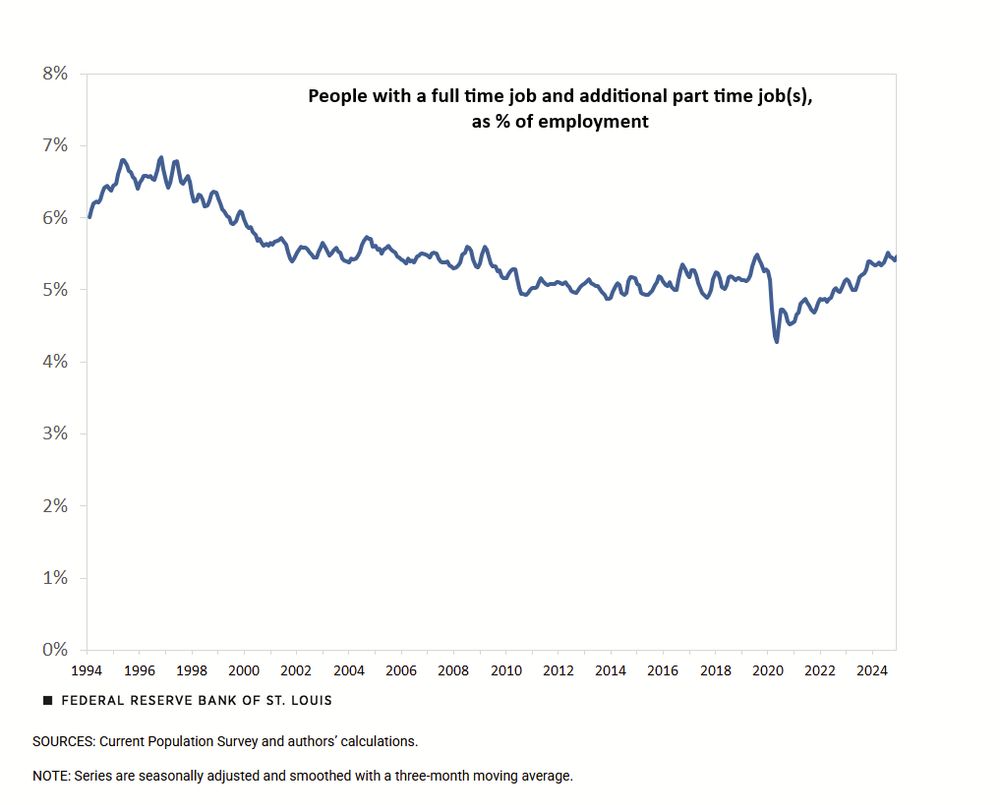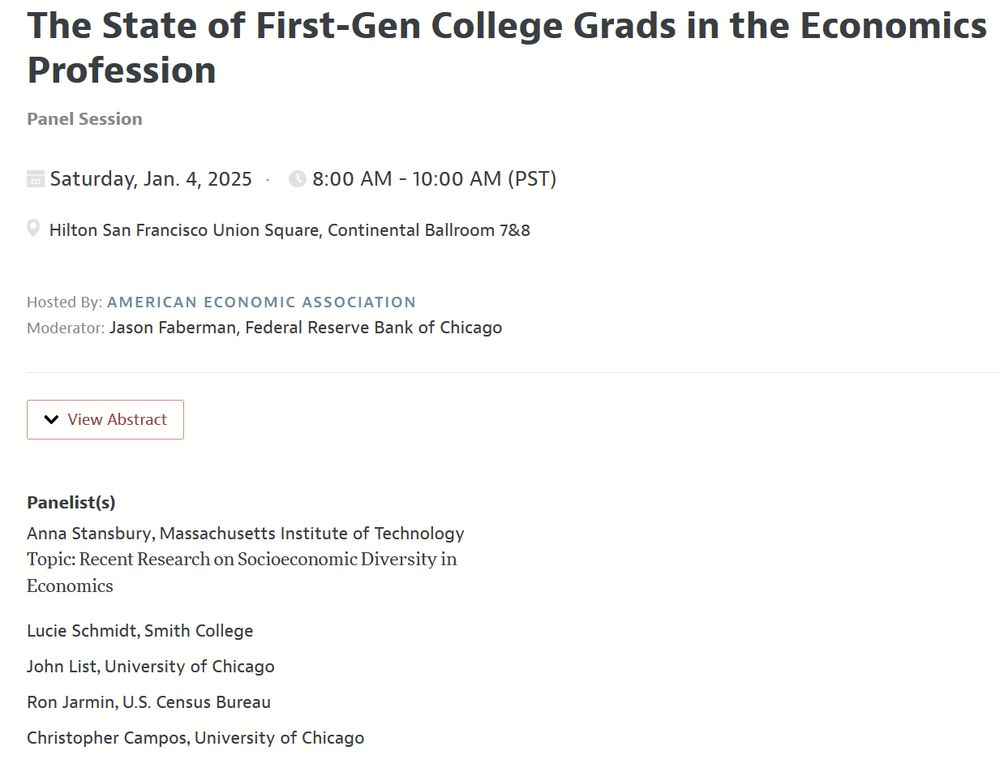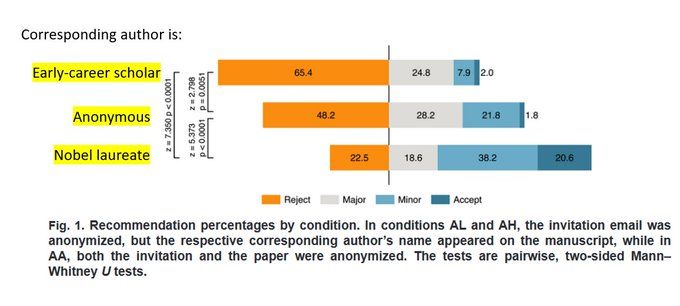Anyone can register to attend here: sites.google.com/view/rnim-se...

Anyone can register to attend here: sites.google.com/view/rnim-se...
Counter to: "people need to work more jobs just to make ends meet" popular conception.
The % of people who work a full time job plus additional jobs has been stable for decades

Counter to: "people need to work more jobs just to make ends meet" popular conception.
The % of people who work a full time job plus additional jobs has been stable for decades

Well, superb new work by Raffaele Saggio & co answers this…!

Well, superb new work by Raffaele Saggio & co answers this…!
CEO pay falls by a cumulative 60% over 5 years
Top execs by 40%
Striking endorsement of the view that strong shareholders help solve the principal agent problem
Paper by Falato, Kim & von Wachter

CEO pay falls by a cumulative 60% over 5 years
Top execs by 40%
Striking endorsement of the view that strong shareholders help solve the principal agent problem
Paper by Falato, Kim & von Wachter
22% of intergenerational earnings persistence is accounted for by ACCESS to high paying firms (AKM firm effects). A lot of this probably due to networks/connections/discrimination
Data from Israel. Lots more in the paper.


22% of intergenerational earnings persistence is accounted for by ACCESS to high paying firms (AKM firm effects). A lot of this probably due to networks/connections/discrimination
Data from Israel. Lots more in the paper.
*Non-employment effects of the minimum wage*
Looking at…
- workplace injuries
- job satisfaction & amenities
- search effort
- company wage policy
- & effects of CA’s new $15 minimum wage
Tomorrow (Friday) 2.30-4.30pm
Join us !



*Non-employment effects of the minimum wage*
Looking at…
- workplace injuries
- job satisfaction & amenities
- search effort
- company wage policy
- & effects of CA’s new $15 minimum wage
Tomorrow (Friday) 2.30-4.30pm
Join us !
Where does the union wage premium come from?
How do firms respond to the min wage?
What’s the role of firms in intergen mobility?
Very excited to be presenting in this #ASSA2025 session tomorrow (Friday) 10.15-12.15
Come join!



Where does the union wage premium come from?
How do firms respond to the min wage?
What’s the role of firms in intergen mobility?
Very excited to be presenting in this #ASSA2025 session tomorrow (Friday) 10.15-12.15
Come join!
w/ @johnlist.bsky.social
@luciegschmidt.bsky.social
@ronjarmin.bsky.social
Chris Campos
Jason Faberman
& me
& lots of time for audience discussion
Please join us Saturday at (gulp) 8am

w/ @johnlist.bsky.social
@luciegschmidt.bsky.social
@ronjarmin.bsky.social
Chris Campos
Jason Faberman
& me
& lots of time for audience discussion
Please join us Saturday at (gulp) 8am
- New survey data on labor standards compliance
- Management practices & workplace injuries
- Wage theft by demographic group
- Compliance incentives
Sunday, 1-3pm
#ASSA2025 #LERA2025 #EconSky

Each coefficient is the percentage point change in likelihood of joining the union, relative to the baseline condition (in parentheses)

Each coefficient is the percentage point change in likelihood of joining the union, relative to the baseline condition (in parentheses)
Do tune in - would love to hear your comments :)
www.nber.org/conferences/...

Do tune in - would love to hear your comments :)
www.nber.org/conferences/...
from my coauthors on UK regional inequality: Dan Turner, Nyasha Weinberg, Esme Elsden, Ed Balls
sites.harvard.edu/uk-regional-...

from my coauthors on UK regional inequality: Dan Turner, Nyasha Weinberg, Esme Elsden, Ed Balls
sites.harvard.edu/uk-regional-...
Strikingly in the UK young non college women also now earn more than young non college men

Strikingly in the UK young non college women also now earn more than young non college men
The return to “skill” as measured by worker fixed effects has FALLEN within routine occupations, but not really within manual or abstract occupations
He uses this to argue that we’ve seen “skill-replacing” Routine Biased Technical Change

The return to “skill” as measured by worker fixed effects has FALLEN within routine occupations, but not really within manual or abstract occupations
He uses this to argue that we’ve seen “skill-replacing” Routine Biased Technical Change

>300 people refereed the same econ paper, with author listed as
1. an early career scholar
2. anonymous
3. a Nobel laureate (from same university as 1)
Recommendations:
65% reject for early career scholar,
23% reject for Nobel laureate
😑
www.pnas.org/doi/epub/10....

>300 people refereed the same econ paper, with author listed as
1. an early career scholar
2. anonymous
3. a Nobel laureate (from same university as 1)
Recommendations:
65% reject for early career scholar,
23% reject for Nobel laureate
😑
www.pnas.org/doi/epub/10....
NO. There is also a class gap in career progression for PhDs in industry. Specifically: a pay gap, a gap in job satisfaction, and widening gaps in pay and in managerial responsibilities over the career (conditional on baseline FEs). (20/22).

NO. There is also a class gap in career progression for PhDs in industry. Specifically: a pay gap, a gap in job satisfaction, and widening gaps in pay and in managerial responsibilities over the career (conditional on baseline FEs). (20/22).
Yes - the class gap in institution type ALSO comes alongside a class pay gap in academia, and a class gap in job satisfaction.
(18/22)

Yes - the class gap in institution type ALSO comes alongside a class pay gap in academia, and a class gap in job satisfaction.
(18/22)
- even conditional on employer institution, tenure status, detailed measures of prior publication record, *and* prior NSF award receipt.
(16/22)

- even conditional on employer institution, tenure status, detailed measures of prior publication record, *and* prior NSF award receipt.
(16/22)
(15/22)

(15/22)
1. COAUTHOR HOMOPHILY: first-gen college grads are more likely to coauthor with other first-gen college grads than you would predict from coauthors' characteristics (inst, field, race, gender, etc) (13/22)

1. COAUTHOR HOMOPHILY: first-gen college grads are more likely to coauthor with other first-gen college grads than you would predict from coauthors' characteristics (inst, field, race, gender, etc) (13/22)
Another candidate: NETWORKS
Differential social & cultural capital, as well as homophily, could make it harder for lower-SEB academics to form valuable professional relationships (11/22)

Another candidate: NETWORKS
Differential social & cultural capital, as well as homophily, could make it harder for lower-SEB academics to form valuable professional relationships (11/22)
– and not so much from lower-SEB academics being more likely to be “underplaced”.
(10/22)

– and not so much from lower-SEB academics being more likely to be “underplaced”.
(10/22)




